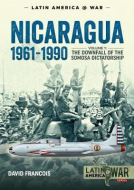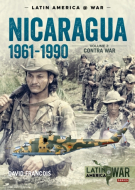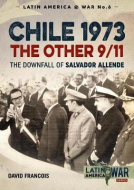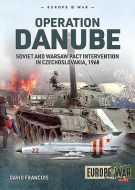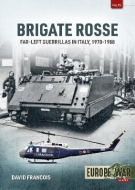
- Agriculture
- Architecture & Design
- Arts & Photography
- Biography
- Business
- Calendars and Diaries
- Childrens (All)
- Childrens (Illustrated)
- Childrens (Picture flats)
- Childrens (Te Reo)
- Classics
- Cooking, Food & Drink
- Craft & Hobbies
- Design (Art / Graphics)
- Design (Interiors)
- Education
- Fashion
- Fiction & Literature
- Fiction - Young Adult
- Gift Ideas
- Health & Wellbeing
- History
- Home & Garden
- Humour & Gift
- Instead of a Card Poems
- Military
- Music
- New Zealand
- NZ (History)
- NZ (Landscapes)
- NZ (Pictorial)
- Poetry
- Reference
- Religion & Faith
- Science & Nature
- Sport & Recreation
- Stationery
- Taschen : 40th Anniversary Edition
- Taschen : BA Basic Art
- Taschen : BU Bibliotheca Universalis
- Te Reo Māori
- Transport
- Travel
David Francois (5)
|
Nicaragua 1961-1990 Volume 1 (Latin America@War 10)
ISBN: 9781911628217 Author: David Francois Publisher: Helion & Company In the wake of the US invasion of Nicaragua in 1912, the country came under the rule of the Somoza family, which imposed a brutal and corrupt military dictators... In the wake of the US invasion of Nicaragua in 1912, the country came under the rule of the Somoza family, which imposed a brutal and corrupt military dictatorship. A low-scale insurgency of students, supported by peasants and other anti-Somoza elements of the society developed already in the 1960s. By the 1970s, the country became embroiled in a brutal insurgency. Supported by Cuba, a coalition of students, farmers, businessmen, clergy and a small group of Marxists launched a major war in 1978, which resulted in the downfall of the Somozas, a year later. The Sandinista government established in Managua of 1979 found the country ruined by the long war and natural disasters, and nearly half of the population either homeless or living in exile. Attempting to restructure and recover the underdeveloped economy, Sandinisas introduced a wide range of reforms and a cultural revolution. Considering the Sandinistas for 'Cuban-supported Marxists' and therefore a major threat for the US domination of Latin America, in 1980-1981 the USA began supporting the creation of the Contrarevolutionary forces (better known as 'Contras'), and thus helped provoke a new war that was to rage through Nicaragua for most of that decade, and is going to be covered in Volume 2 of this mini-series. Leaning upon extensive studies of involved armed groups, and their insurgencies in the 1960s and 1970s, 'Nicaragua, 1961-1990, Volume 1' provides an in-depth coverage of military history during the first phase of one of major armed conflicts of Latin America in modern times. Guiding the reader meticulously through the details of involved forces, their ideologies, organization and equipment, this book is offering a uniquely accurate, blow-by-blow account of the Nicaraguan War and profusely illustrated with more than 120 photos, maps, and color artworks. Bind: paperback Pages: 72 Dimensions: 210 x 300 mm Publication Date: 04-01-2019 |
$49.99 |
|
|
Nicaragua 1961-1990 Volume 2 (Latin America@War 15)
ISBN: 9781911628682 Author: David Francois Publisher: Helion & Company In 1979, the Sandinista government established itself in power in Managua, the capitol of Nicaragua. It found the country ruined by the long war against the Som... In 1979, the Sandinista government established itself in power in Managua, the capitol of Nicaragua. It found the country ruined by the long war against the Somosa dictatorship and natural disasters alike, and nearly half of the population either homeless or living in exile. Attempting to restructure and recover the underdeveloped economy, Sandinisas introduced a wide range of reforms and a cultural revolution. Considering the Sandinistas to be ‘Cuban-supported Marxists’ and therefore a major threat to the US domination of Latin America, in 1980-1981 the USA began supporting the creation of the Contrarevolutionary forces (better known as ‘Contras’), and thus helped provoke a new war that was to rage through Nicaragua until 1988. Leaning upon extensive studies of the armed groups involved, and their combat operations of the 1981-1988 period, ‘Nicaragua, 1961-1990, Volume 2’ provides an in-depth coverage of military history during the second phase of one of bloodiest, and most-publicised armed conflicts of Latin America in modern times. Guiding the reader meticulously through the details of the involved forces, their ideologies, organisation and equipment, this book offers a uniquely accurate, blow-by-blow account of the Nicaraguan War and is profusely illustrated with more than 120 photos, maps, and colour artworks. Bind: paperback Dimensions: 210 x 300 mm Publication Date: 15-07-2019 |
$49.99 |
|
|
Chile 1973 (Latin America@War 6)
ISBN: 9781912174959 Author: David Francois Publisher: Helion & Company In 1970, Salvador Guillermo Allende Gossens, a physician and leftist politician, was elected the President of Chile. Involved in political life for nearly 40 ye... In 1970, Salvador Guillermo Allende Gossens, a physician and leftist politician, was elected the President of Chile. Involved in political life for nearly 40 years, Allende adopted a policy of nationalization of industries and collectivization - measures that brought him on a collision course with the legislative and judicial branches of the government, and then the center-right majority of the Chilean Congress. Before long, calls were issued for his overthrow by force. Indeed, on 11 September 1973, the military - supported by the Central Intelligence Agency (CIA) of the USA - moved to oust Allende, and surrounded La Moneda Palace. After refusing a safe passage, Allende gave his farewell speech on live radio, and La Moneda was then subjected to air strikes and an assault by the Chilean Army. Allende committed suicide. Following Allende's death, General Augusto Pinochet installed a military junta, thus ending almost four decades of uninterrupted democratic rule in the country. His repressive regime remained in power until 1990. Starting with an in-depth study of the Chilean military, paramilitary forces and different leftist movements in particular, this volume traces the history of the build-up and the ultimate clash during the coup of 11 September 1973. Providing minute details about the motivation, organization and equipment of all involved parties, it also explains why the Chilean military not only launched the coup but also imposed itself in power, and how the leftist movements reacted Illustrated with over 100 photographs, color profiles, and maps describing the equipment, colors, markings and tactics of the Chilean military and its opponents, it is a unique study into a well-known yet much under-studied aspect of Latin America's military history. Bind: paperback Pages: 72 Dimensions: 210 x 297 mm Publication Date: 18-05-2018 |
$49.99 |
|
|
Operation Danube (Europe@War 7)
ISBN: 9781913336295 Author: David Francois Publisher: Helion & Company On 20 August 1968, hundreds of thousands of soldiers, dozens of thousands of tanks and armored vehicles, and hundreds of military aircraft of the Warsaw Pact ar... On 20 August 1968, hundreds of thousands of soldiers, dozens of thousands of tanks and armored vehicles, and hundreds of military aircraft of the Warsaw Pact armed forces invaded Czechoslovakia in an operation code-named Danube. It was the largest military undertaking in Europe since 1945. Starting with a description of the history of Czechoslovakia, especially after the communist takeover of power in 1948, this volume describes the birth and development of the Prague Spring in 1968 and an attempt to reform the communist system from within. It recounts the hostility this process encountered on the part of the Union of Soviet Socialist Republics (USSR/Soviet Union), and its allies within the Warsaw Pact, and provoked a split in the Kremlin about solutions for the resulting 'Czechoslovak problem'. The crisis that developed throughout the spring and summer of 1968 led to the military intervention. While paying special attention to the military and strategic aspects of the Czechoslovak crisis, this volume also provides a blow-by-blow account of its impacts upon the Czechoslovak armed forces and the Warsaw Pact. The subsequent military operation - codenamed Operation Danube - is described in all of its components, including the airborne and ground aspects, and the political operation that supported it. Within only 24 hours, the Soviet and Warsaw Pact forces secured the entire territory of Czechoslovakia, de-facto overrunning the local armed forces in the process. The Czechoslovak population organized nonviolent resistance, thus highlighting the political aspects of the intervention. However, it was hopelessly out of condition to prevent the ultimate downfall of the so-called 'Prague Spring', and the related hopes. Bind: paperback Pages: 72 Dimensions: 210 x 297 mm Publication Date: 23-11-2020 |
$49.99 |
|
|
Brigate Rosse (Europe@War 15)
ISBN: 9781914377075 Author: David Francois Publisher: Helion & Company Widespread unrest and political violence shook Italy time and again during the decades following the end of the Second World War, but never as much as during th... Widespread unrest and political violence shook Italy time and again during the decades following the end of the Second World War, but never as much as during the 1970s and the 1980s. Seeking to counter political enemies - including a conglomerate of right-wing movements, organized crime, and top figures in the economic and political life of the country - in order to create a revolutionary state through an armed struggle, and to remove Italy from the North Atlantic Treaty Organization, in 1970, leftists in Italy began to form the Brigade Rosse - the Red Brigades. Organizing themselves following the examples of the Latin American urban guerrilla movements, and also drawing inspiration from the Italian partisan movement of the Second World War, the Brigate Rosse emerged in Trento in 1970. Their early activities were troubled by infighting between 'extremist' and 'moderate' wings of the movement, with the latter accusing some of leaders of having links to the intelligence services of several East European countries. Bind: paperback Pages: 80 Dimensions: 210 x 297 mm Publication Date: 15-12-2021 |
$49.99 |


